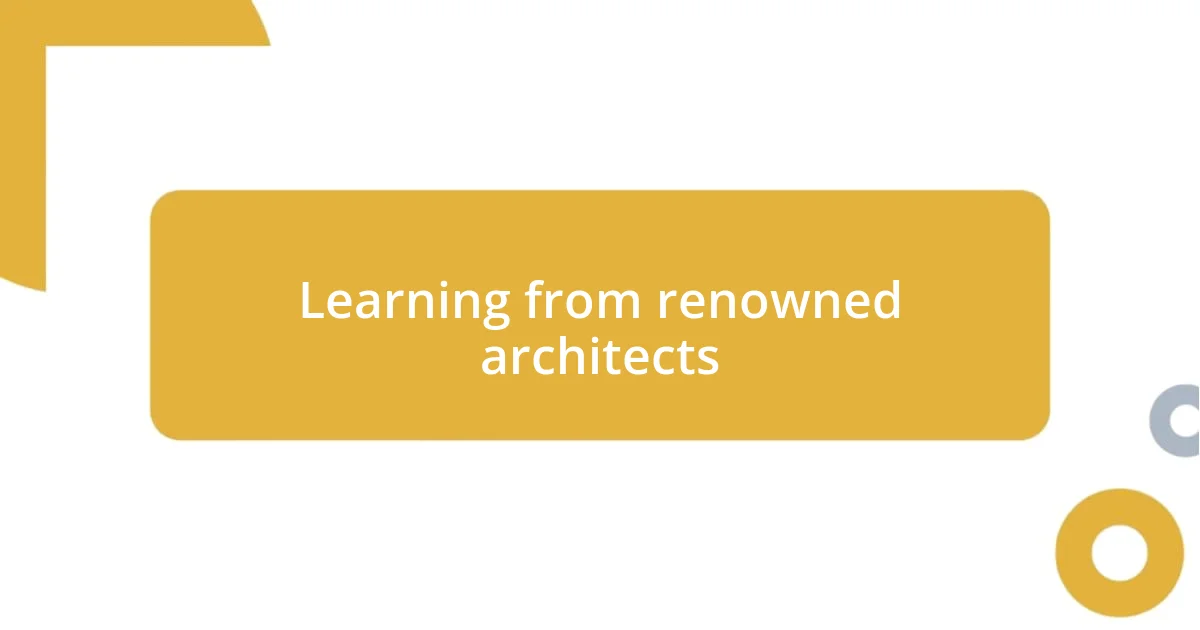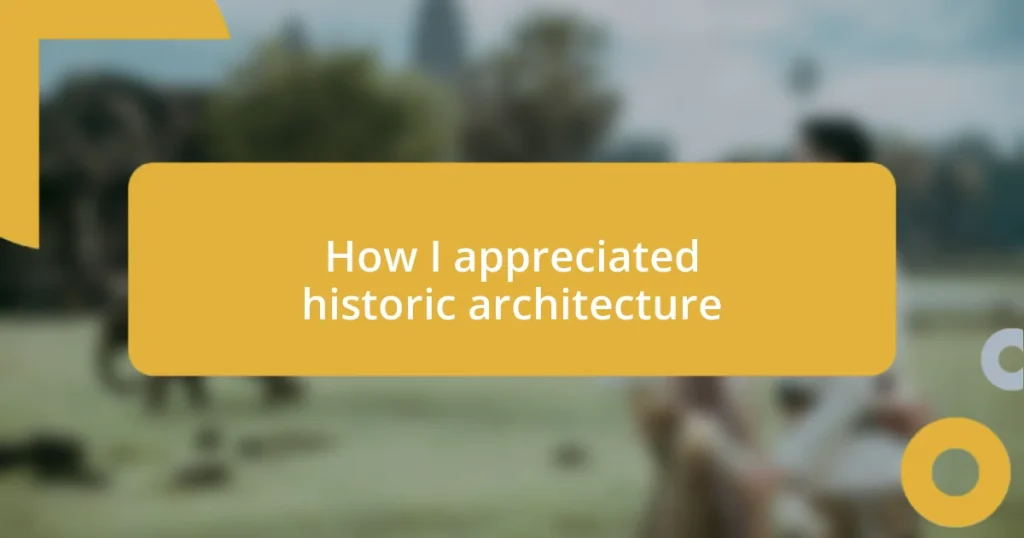Key takeaways:
- Historic architecture serves as a connection to the past, offering insight into the values and stories of previous generations.
- Different architectural styles reflect cultural shifts and technological advancements, enhancing our appreciation of human creativity.
- Engaging with the community through discussions and educational initiatives fosters a deeper understanding and appreciation of local architectural heritage.

Understanding historic architecture
Understanding historic architecture takes us beyond just admiring beautiful buildings; it invites us to explore the stories they tell. Each structure is a window into the past, showcasing the values, technologies, and artistic expressions of the time it was built. Have you ever glanced at a crumbling stone wall and wondered who touched it before you? That connection to history can be incredibly moving.
When I visited a charming old library in a small town, I felt an overwhelming sense of reverence as I stood beneath its grand arches. The intricate woodwork and stained glass felt like a tribute to the craftsmen who dedicated their lives to creating something beautiful and lasting. It struck me that every architectural detail was not just functional but also infused with emotion and passion. What stories do you think those walls could share if they could speak?
Historic architecture doesn’t simply hold aesthetic value; it serves as a tangible link to our collective heritage. Walking through an ancient marketplace, I was captivated by the vibrant life it still housed. It got me thinking: how many generations have gathered there, sharing food, stories, and lives? This kind of deep understanding of architecture draws us into a dialogue with the past, enriching our experience of the present.

Exploring significant architectural styles
Exploring significant architectural styles reveals the incredible diversity and cultural significance inherent in structures from around the world. For example, Gothic architecture’s soaring cathedrals evoke an air of spirituality and grandeur, almost like they’re reaching for the heavens. When I first stood before the intricate facade of a Gothic cathedral, I remember feeling overwhelmed by the sheer scale and artistry that had gone into every spire and gargoyle.
In contrast, the sleek simplicity of modernist architecture promotes functionality and a clean aesthetic, often blending seamlessly into the landscapes they inhabit. I once visited a modern art gallery housed within a minimalistic building, and the design itself seemed to invite creativity, letting the artwork take center stage. It made me reflect on how architectural choices can enhance our experiences in spaces that matter to us.
These distinctions among architectural styles not only illustrate different artistic visions but also reflect cultural shifts and technological advancements. Reflecting on my travels, I’ve seen how Italian Renaissance architecture celebrates humanism with its symmetry and proportion, while also feeling like a homage to the ancient Greeks and Romans. Each architectural style, rich with its own history, fosters a greater appreciation of the layers of human experience embedded in our built environment.
| Architectural Style | Key Features |
|---|---|
| Gothic | Pointed arches, ribbed vaults, flying buttresses |
| Modernist | Simplicity, functionality, open space, absence of ornamentation |
| Renaissance | Symmetry, proportion, Greek and Roman influences |

Learning from renowned architects
Learning from renowned architects opens a treasure trove of inspiration and insight. I remember visiting the studio of a contemporary architect, and their passion for blending the old with the new was palpable. They spoke about how each project starts with understanding its context, the stories of the people who inhabit it, and the history the site carries. This philosophy resonated deeply with me, illustrating how even the most modern designs can honor the past while paving the way for the future.
Here are some key lessons I’ve gleaned from various architects:
- Context Matters: Renowned architects consider the environment and history when designing, ensuring harmony with the surroundings.
- Emotional Connection: Great architecture evokes feelings; it can inspire, comfort, or even provoke thought.
- Innovation with Tradition: Many architects blend modern techniques with historical styles, reminding us that innovation doesn’t have to erase the past.
- Sustainability: A growing number of architects prioritize eco-friendly materials and designs, aligning creativity with a commitment to our planet.
- Functionality Meets Aesthetics: The best designs marry beauty with practicality, enhancing everyday experiences in profound ways.
Reflecting on my own experiences, seeing how an architect transformed a dilapidated warehouse into a vibrant community hub was electrifying. The juxtaposition of old bricks and modern glass created a space that felt alive, teeming with possibility. It highlighted for me that learning from the past, while embracing new ideas, leads to truly extraordinary outcomes.

Appreciating cultural influences in design
Appreciating cultural influences in design opens our eyes to the stories embedded within every structure. I recall wandering through the vibrant streets of Marrakech, where the intricate tile work and arched doorways seemed to pulse with the spirit of a rich history. Have you ever found yourself transported through time by a building? That’s the magic of architectural traditions—they carry cultural narratives that resonate with the essence of a place and its people.
One of the aspects that captivates me most is how architecture reflects a society’s values and aspirations. When I visited traditional Japanese tea houses, the seamless integration with nature spoke volumes about harmony and simplicity. The use of natural materials and a focus on tranquility made each space a gentle reminder of mindfulness. Have you ever noticed how certain designs can evoke specific feelings? It’s fascinating how cultural designs capture the essence of beliefs and customs, creating environments that feel uniquely profound.
I also think about the bold colors and geometric patterns of Mexican architecture, which express a vibrant cultural identity. During a trip to Oaxaca, I found myself drawn to a local market surrounded by buildings adorned with bright murals. The lively colors seemed to tell stories of the community’s heritage and resilience. How do these cultural influences alter our perception? Each design language, from the ornate detailing of Baroque structures to the minimalism of Scandinavian homes, serves as a testament to the diversity of human creativity and aspiration. It’s a beautiful reminder that every design choice reflects a rich tapestry of cultural history, and I find that incredibly inspiring.

Engaging with local historical tours
Visiting local historical tours has always been a passion of mine, and each experience feels like a personal journey through time. On a walking tour in my hometown, the guide shared fascinating stories about the buildings, including one that dated back to the 1800s. I was amazed to learn of the resilience of those who lived in and around these structures during challenging times. Have you ever felt a sense of connection with a place just by hearing its history? That feeling can be profound.
There’s something truly special about how these tours allow you to immerse yourself in the architectural details. I remember standing in front of a beautifully crafted Victorian house, its ornate woodwork whispering secrets of the past. The tour guide pointed out hidden symbols carved into the doors, suggesting a forgotten story that lingered in the air. These small details made me realize that each brick laid and every arch designed has lived through decades of human experience. Can you imagine how many lives these buildings have touched?
Engaging with local historical tours offers a unique opportunity to appreciate craftsmanship and storytelling intertwined in architecture. I recall an afternoon spent exploring an old city hall, where the echoes of past discussions seemed to reverberate through the grand halls. As I stood under the intricately painted ceiling, I felt inspired by the collective history housed within those walls. It made me ponder: what stories do our modern buildings hold? Understanding this connection fuels my admiration for historic architecture and deepens my desire to preserve these narratives for future generations.

Documenting experiences through photography
Documenting experiences through photography offers an intimate glimpse into the world of architecture that words alone often fail to capture. I can still remember standing outside a grand Gothic cathedral, the intricate spires reaching skyward, and feeling compelled to pull out my camera. Each click felt less like a mere snapshot, and more like a way to pause time—an attempt to hold on to that momentary blend of awe and inspiration. Have you ever stood before a stunning facade and wished you could keep that feeling forever?
As I explored the bustling streets of Rome, my camera became my best friend, helping me immortalize those fleeting moments of beauty. I snapped photos not just of the renowned landmarks but also of the quiet corners, where ivy clung to weathered bricks. Each image serves as a portal back to my experiences, allowing me to relive the colors, textures, and emotions of that day. Isn’t it amazing how a single photograph can transport you right back to a specific moment?
While editing my photos afterward, I realized how storytelling through imagery helps others appreciate historic architecture. Capturing the shadows cast by old stonework or the warm glow of sunset illuminating a façade can create a narrative that resonates deeply. I often find myself asking, how does each image reflect the story behind the structure? By documenting these experiences, I aim to share the unique beauty and history of each place, sparking curiosity in those who view them.

Sharing insights with communities
I love how sharing insights about historic architecture with the community fosters a deeper connection to our collective heritage. One Saturday, I held a small gathering in my living room where I invited friends to discuss the local landmarks we often took for granted. We poured over old photographs and discussed the changes over the years, and I was surprised by how those discussions sparked passion in everyone. Have you ever seen someone’s eyes light up when they realize a building holds a piece of their own story?
During a recent neighborhood festival, I set up a booth to showcase local architecture’s rich history. I displayed photographs alongside artifacts, which quickly drew in curious passersby. I vividly recall an elderly man stopping by—his face beaming as he shared his childhood memories of playing in front of those very buildings. That moment reminded me of the incredible value in exchanging experiences. Isn’t it magical how stories can breathe new life into structures we might overlook every day?
In collaborating with local schools to organize educational workshops, I’ve seen firsthand how engaging young minds can shape their understanding of our architectural landscape. I vividly remember listening to students passionately debate their favorite buildings and imagining how they might design their own. Bringing that enthusiasm into the community cultivates a sense of ownership and responsibility. How can we preserve a place if we don’t connect with its history? Encouraging these conversations not only enriches our understanding but also inspires the next generation to appreciate and protect our architectural legacy.















